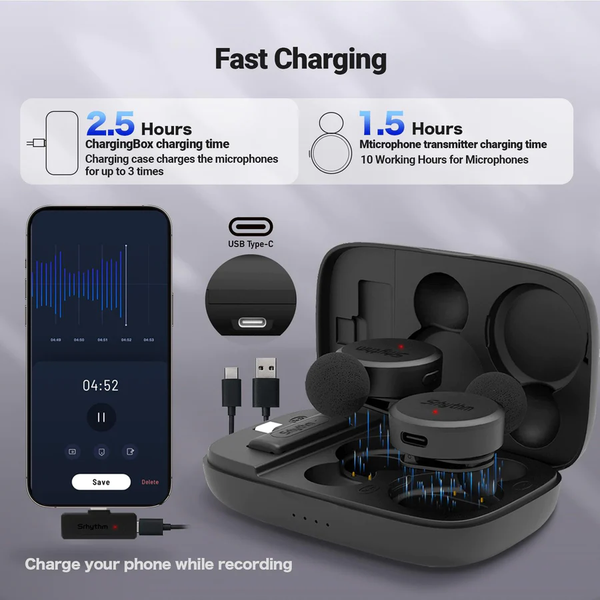
In the dynamic and ever-evolving realm of audio recording and broadcasting, the imperative for high-quality sound capture cannot be overstated. With the technological innovation of long-range wireless Lavalier microphones, both professionals and enthusiasts are venturing into uncharted territories of sound recording. These state-of-the-art devices are revolutionizing the industry, offering unprecedented mobility without compromising on the clarity and integrity of audio signals, even over extensive distances. This exploration delves deep into the myriad benefits and groundbreaking advancements of these innovative microphones, with a spotlight on the contributions of leading brands like Srhythm. Their work is pivotal in transforming the audio recording landscape, ushering in a new era where limitations of distance and mobility are effectively obliterated.
Unleashing the Power of Long-Range Wireless Technology
Breaking the Barriers with Extended Range
The allure of long-range wireless Lavalier microphones is predominantly rooted in their exceptional ability to capture audio from significant distances, a feat unattainable with traditional wired microphones. By harnessing advanced transmission technologies, including Wi-Fi and the robust 2.4 GHz frequencies, these wireless systems facilitate seamless audio capture from afar.
This breakthrough technology is a game-changer for live performances, film production, and broadcasting sectors, where the essence of mobility and the necessity to bridge distances without sacrificing sound quality are paramount. The integration of these cutting-edge transmission technologies not only ensures a consistent and reliable audio signal over long distances but also significantly expands the scope of creative possibilities, allowing audio professionals to achieve pristine sound quality in a variety of challenging environments.
Multi-Channel Support for Clutter-Free Transmission
In the contemporary landscape of wireless microphone systems, the multi-channel capabilities engineered by innovators like Srhythm stand out as a cornerstone feature for clutter-free audio transmission. In scenarios where the airwaves are congested with multiple audio streams, the potential for signal interference and cross-talk is high. However, the advanced multi-channel support offered by these systems addresses this challenge head-on. By enabling the selection of distinct channels for each microphone, each audio stream is assigned a unique frequency for transmission. This critical feature not only prevents the overlap of audio signals but also preserves the pristine quality of the sound captured. The significance of multi-channel support extends beyond merely preventing interference; it enhances the flexibility and scalability of audio recording setups, making it feasible to orchestrate complex audio captures in densely populated audio environments. This technology is pivotal for live events, multi-speaker engagements, and professional-grade audio productions, where clarity and distinction of sound are non-negotiable.
The progression towards long-range wireless Lavalier microphones, exemplified by the innovations from Srhythm and others in the field, is not just a leap in technology. It represents a paradigm shift in how sound is captured and transmitted, ensuring that distance no longer poses a barrier to high-quality audio recording. This evolution paves the way for a future where audio r
Enhancing Audio Quality and Versatility

The pursuit of superior sound quality and versatility in audio recording has led to significant advancements in microphone technology. Among these, the transition from analog to digital wireless microphones and the expansion of frequency range capabilities stand out as critical developments. These innovations have not only elevated the quality of sound captured but have also broadened the scope of applications for lavalier microphones, making them indispensable tools in a variety of professional settings.
From Analog to Digital: A Leap in Sound Clarity
The shift from analog to digital wireless microphones represents a monumental stride forward in the quest for impeccable sound clarity. Digital microphones have been engineered to overcome the limitations of their analog predecessors by significantly reducing background noise and interference. This leap in technology ensures that the audio captured is not just louder but clearer and more natural sounding.
In professional settings, where every nuance of sound can be critical, the benefits of digital wireless microphones cannot be overstated. They offer a robust solution to common audio recording challenges, delivering crisp, clear sound even in environments prone to electromagnetic interference. This clarity and reliability make digital wireless microphones the gold standard for professionals who cannot afford compromises in audio quality.
The Role of Frequency Range in Picking Up Sound
Equally important in the evolution of Lavalier microphones is the enhancement of their frequency range capabilities. Modern advanced lavalier microphones boast a wide frequency range, enabling them to capture a broad spectrum of sounds, from the deep resonances of the lowest bass to the crystal-clear pitches of the highest treble. This wide frequency range is pivotal for accurately reproducing the natural nuances of sound, a critical aspect of professional audio recording.
The capability to pick up a wide array of sounds makes these microphones exceptionally versatile, and suitable for a diverse range of applications. Whether it's capturing the delicate timbre of a live musical performance, the nuanced dialogue of a film, or the dynamic range of sounds in a television production, lavalier microphones with a broad frequency range are indispensable. They ensure that the audio recorded is not just heard but felt, conveying the full emotional and acoustic depth of the performance.
Comparing Microphone Types: Lavalier Vs. Shotgun
The landscape of wireless microphones is diverse, with each type designed to meet specific recording needs. Two of the most commonly used microphones in professional audio capture are lavalier and shotgun microphones. Both bring unique advantages to the table, catering to different scenarios and requirements.
Lavalier Microphones: Discretion and Versatility
Lavalier microphones, often referred to as lapel mics, are celebrated for their compact size and ability to offer high-quality sound capture discreetly. These small, clip-on devices are designed to be attached to the clothing of the speaker, allowing for hands-free operation. This makes Lavalier mics an ideal choice for television broadcasts, interviews, and live performances where freedom of movement is crucial, and visual obtrusiveness must be minimized. The discreet nature of lavalier mics also makes them perfect for theater productions, where microphones need to be invisible to the audience.
The primary advantage of Lavalier microphones lies in their portability and the ability to capture natural-sounding audio directly from the source without picking up too much ambient noise. However, their performance can be influenced by the positioning of the body and the type of clothing worn by the speaker.
Shotgun Microphones: Directionality and Precision
Shotgun microphones stand on the other end of the spectrum, offering highly directional audio capture. These mics are designed to pick up sound from a specific direction, minimizing background noise and focusing on the audio directly in front of them. This makes shotgun mics exceptionally well-suited for film and video production, where capturing clear audio from a subject in noisy environments or at a distance is necessary.
The elongated design of shotgun microphones allows them to reject sounds from the sides and rear, focusing on audio that originates from the direction the microphone is pointed. This directional capability is invaluable in scenarios where the subject is moving, or multiple sound sources need to be isolated.
Srhythm Wireless Microphones Are Set for Success

Battery Life and Durability: The Road Ahead
Battery life and durability have always been at the core of wireless microphone innovation, and Srhythm stands out as one of the leaders in developing long-lasting lavalier microphones that meet this goal with durability features that include extended battery life as well as being designed to withstand prolonged use without changing batteries frequently or fear of equipment breakdowns during recording sessions. Srhythm's m1 leadership in these regards enables professionals to depend on their equipment without frequent battery changes interrupting sessions or fearing equipment failure during long recording sessions without worrying about equipment failure due to frequent battery changes or replacement needs during recording sessions!
As digital transformation transforms the audio industry, Srhythm has emerged at the forefront. Their cutting-edge wireless microphone systems include Wi-Fi connectivity and secure transmission through encryption technology for enhanced functionality and increased possibilities of use. Remote recording/broadcasting capability opens new avenues for audio professionals looking for innovative ways to capture high-quality sound recordings.
Conclusion
Long-range wireless Lavalier microphones represent a significant leap forward in the field of audio recording. By combining extended range, multi-channel support, superior sound quality, and the convenience of wireless operation, these devices are setting new standards in audio capture technology. With companies like Srhythm leading the way, the future of wireless audio recording looks brighter than ever, promising a perfect blend of technology and artistry that will continue to push the boundaries of what is possible.




